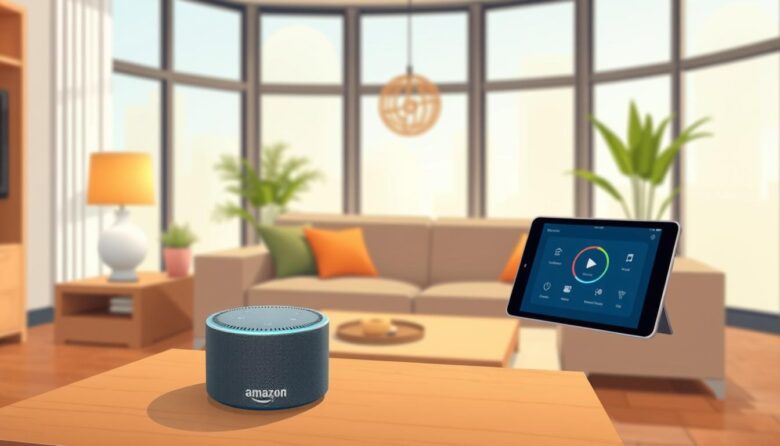Welcome to your guide on modern home technology. This resource explores how voice commands are changing daily life. These systems offer simple solutions for managing your living space.
Imagine adjusting lights or playing music with just a spoken word. This technology is no longer a futuristic dream. It provides real convenience for busy households today.
Adoption of this technology is growing rapidly. By 2028, nearly 170 million Americans are projected to use voice assistants. This shows a major shift towards hands-free control.
Our guide will help you understand the major platforms. We cover Google Assistant, Amazon Alexa, and Apple Siri. You will learn to choose the right system for your needs and budget.
Get ready for detailed comparisons and setup advice. We focus on practical value to help you create a smarter, more efficient home.
Understanding Voice-Controlled Devices
Modern voice-enabled technology operates by converting spoken words into actionable commands through sophisticated processing. These systems break down speech into tiny sound units called phonemes. Advanced algorithms then analyze these patterns to understand what you’re saying.
Natural language processing gives these systems true intelligence. This technology helps them grasp context and intent behind your words. It can parse complete sentences and recognize various speech patterns.
The technology adapts to different accents and speaking styles. This makes voice assistants more accessible to diverse users. Machine learning allows these systems to improve over time.
You’ll find this technology in many products today. Smart speakers, phones, and home appliances all use voice control. Even cars now integrate voice assistant capabilities.
Hands-free operation represents the key advantage of this technology. It makes daily tasks simpler and more efficient. People with different abilities find this approach particularly helpful.
This foundation helps you evaluate specific products effectively. Understanding the core technology ensures you make informed choices for your smart home setup.
The Evolution of Voice Recognition Technology
Early voice recognition systems could barely understand simple commands. They were limited to basic tasks like phone dialing. The technology has come a long way since those first steps.
Breakthroughs in artificial intelligence and machine learning changed everything. These advances allowed systems to learn from interactions over time. This led to a massive improvement in accuracy and responsiveness.
Modern systems now understand natural language and conversational context. They can manage entire smart home ecosystems. This evolution shows incredible technological progress.
User confidence has grown alongside these improvements. In 2023, about 145 million Americans used voice assistants. This number is projected to reach 170 million by 2028.
Faster processing power and cloud computing make interactions feel instant. This historical journey helps us appreciate the maturity of today’s voice recognition tools. They are the result of years of refinement.
Voice-Controlled Devices: Enhancing Daily Living
Practical applications demonstrate how voice technology enhances quality of life through convenience. These systems transform routine household management into seamless experiences.
Hands-free operation proves invaluable for common tasks. Users can set reminders, create shopping lists, and find recipes while cooking. This eliminates the need to stop current activities.
Instant information access represents another key benefit. Weather updates, news briefings, and traffic reports are available on demand. Quick responses save valuable time during busy mornings.
Entertainment capabilities enrich daily living experiences. Voice commands control music playback and streaming services effortlessly. These devices also provide conversational interaction and trivia answers.
The technology makes smart home features accessible to all skill levels. There’s no complex learning curve involved. Simple voice commands handle what previously required app navigation.
Real-world scenarios highlight the practical value. Multitasking parents benefit greatly during meal preparation. Occupied hands no longer interrupt information-seeking or task management.
Key Benefits for Home Automation
Modern households are discovering the transformative power of voice integration in their automation systems. This technology creates a centralized control hub for various home devices. Simple spoken commands replace multiple apps and manual switches.
Voice-activated automation handles complex tasks through customized routines. A single “good morning” command can adjust lighting, temperature, and start coffee makers. These features save time while creating personalized environments.
Market adoption reflects this technology’s value. In 2024, approximately 70 million US households used smart home devices. This represents a 10% increase from 2023 levels.
Energy efficiency becomes effortless with voice-controlled automation. Optimized heating schedules and automated lighting reduce waste. Users can monitor consumption and make adjustments remotely.
Home security gains significant enhancements through voice integration. Residents can check camera feeds, lock doors, and arm systems from anywhere indoors. This provides peace of mind through accessible control.
The convenience factor shines during daily activities. Hands-free operation helps when entering with groceries or cooking. Custom scenes for movie nights or dinners showcase the system’s flexibility.
Top Features to Look for in Voice-Controlled Devices
The market offers numerous options, but understanding essential features helps identify the best fit for your needs. Focus on capabilities that deliver real convenience rather than marketing claims.
These key aspects determine how well your technology will perform in daily use. Smart shoppers prioritize functionality that enhances their living experience.
Voice Recognition Accuracy and Responsiveness
Superior voice recognition separates premium products from basic models. Look for systems that understand commands in noisy environments.
The best devices recognize multiple users and various accents. Fast response times indicate advanced processing capabilities. This ensures smooth interactions without frustrating delays.
Seamless Smart Home Integration
Compatibility with existing smart home devices is crucial. Choose systems supporting multiple protocols like Wi-Fi, Zigbee, and Matter.
This future-proofs your investment as technology evolves. Integrated hubs simplify setup by reducing additional components needed for full home control.
Comparing Popular Voice Assistants: Google Assistant, Alexa, and Siri
When selecting a smart assistant, users face a critical decision between Google, Amazon, and Apple ecosystems. Each platform offers unique advantages tailored to different lifestyles and existing technology investments.
Pros and Cons Breakdown
Google Assistant stands out for its superior natural language understanding. It leverages Google’s vast search database for accurate responses. This assistant integrates seamlessly with Google services like Calendar and Gmail.
Amazon Alexa supports the widest range of smart home devices. Its skills library offers extensive third-party functionality. However, some users report occasional promotional content.
Apple Siri provides excellent integration for iPhone and Mac users. The ecosystem offers strong privacy protections. The main limitation is higher hardware costs and fewer compatible devices.
User Experience and Ecosystem Support
Google Assistant delivers the most responsive experience for general queries. Projections show 92 million US users by 2025. The assistant handles follow-up questions with strong contextual understanding.
Amazon’s ecosystem includes the most hardware options across price points. Support extends to over 100,000 compatible devices. This makes Alexa ideal for comprehensive smart home setups.
Choosing between these assistants requires considering your existing technology. Switching platforms often means replacing multiple integrated devices. Each voice assistant offers distinct advantages for different user needs.
Best Smart Speakers for Every Budget
Finding the perfect smart speaker requires balancing budget, features, and sound quality. Our recommendations cover various price points to match different needs and preferences.
For overall value, the Google Nest Audio at $75 delivers impressive bass and clear vocals. This speaker pairs well with Google Assistant for seamless smart home control. You can combine two units for stereo sound at just $150.
Budget-conscious shoppers should consider the Amazon Echo Dot 5th Gen priced at $50. Despite its compact size, it produces surprisingly robust audio. It’s ideal for smaller spaces like bedrooms or offices.
The JBL Authentics 200 ($350) stands out for audiophiles wanting dual voice assistant support. This premium model works with both Google Assistant and Amazon Alexa simultaneously. Its vintage-inspired design complements its exceptional sound quality.
Smart display options include the Google Nest Hub Max with its 10-inch screen for $230. This device excels as a smart home controller and digital photo frame. The Echo Show 8 offers Alexa users a visual interface at $150.
For superior audio performance, the Sonos Era 100 ($219) connects to nearly every music streaming service. It features room tuning capabilities and multi-room audio support. The Sonos Beam Gen 2 ($459) integrates voice control into home theater systems with Dolby Atmos support.
These smart speakers provide excellent options whether you prioritize sound, display features, or budget considerations. Each model offers distinct advantages for different living spaces and usage scenarios.
Evaluating Sound Quality and User Experience
The listening experience should be a primary consideration in your speaker evaluation process. Technical specifications translate directly to real-world performance across different environments.
Audio Performance and Clarity
Speaker components like woofers and tweeters determine sound quality. The Sonos Era 100 features a 25% larger woofer that effectively fills rooms. Room tuning technology automatically optimizes audio for specific spaces.
Stereo pairing creates immersive soundscapes. Two Google Nest Audio units deliver genuine stereo separation for just $150. This setup rivals more expensive single speakers in audio quality.
Room size impacts speaker selection. Compact speakers work well in bedrooms and offices. Larger spaces require more powerful units to prevent distortion at higher volumes.
Connectivity and Compatibility with Other Devices
Multiple connection options enhance flexibility. Bluetooth allows direct device pairing for wireless turntable connections. Wi-Fi enables streaming from various music services.
Comprehensive service support ensures broad music access. Most devices work with Spotify, Apple Music, Pandora, and Amazon Music. High-definition audio support delivers superior listening quality.
The user experience extends beyond sound quality. Voice control responsiveness and app interface design affect daily usage. Physical controls and setup ease contribute to overall satisfaction with your chosen device.
Integrating Voice-Controlled Devices with Your Smart Home Ecosystem
Seamless integration transforms individual smart devices into a unified home control system. Proper setup ensures your voice commands work across all connected products in your living space.
The Google Home app simplifies connecting speakers with compatible smart devices. This intuitive platform helps you manage rooms, groups, and automation routines from one interface.
Built-in hubs eliminate the need for separate control devices. The Nest Hub Max supports Matter over Thread and Wi-Fi connections. Similarly, the Echo Show 8 works with Zigbee, Matter, and Thread protocols.
Amazon Alexa connects to over 100,000 different smart home products. This extensive compatibility gives users maximum flexibility when selecting lights, locks, and thermostats.
Natural language commands make controlling your environment effortless. You can say “Turn on the bedroom” or “Dim the office lamp” for instant results. More specific commands like “Set the living room lights to 50 percent” demonstrate advanced capability.
The Matter protocol represents an important development for future-proofing your smart home. This emerging standard improves interoperability between different brands and ecosystems. Investing in Matter-compatible devices ensures long-term flexibility.
Cross-platform considerations help maintain system adaptability. Some products work with multiple assistants while others remain ecosystem-specific. Understanding these differences prevents compatibility issues during expansion.
The Role of Voice Commands in Daily Tasks
Verbal instructions are reshaping how we manage routine household activities. Simple spoken words now handle what once required multiple steps and device interactions.
These systems excel at providing instant information. You can ask about the weather forecast or traffic conditions without lifting a finger. They access online databases to deliver accurate updates.
Household management becomes effortless with voice control. Setting multiple timers while cooking or creating shopping lists hands-free are common tasks. You can even convert measurements during recipe preparation.
Lighting control demonstrates the precision of these commands. Adjust brightness in any room or change bulb colors with a simple phrase. Create scenes for different activities like movie nights.
Entertainment commands offer complete audio control. Play specific songs, adjust volume, or manage multi-room playback. The technology understands natural variations in phrasing.
Practical voice commands for smart home control include:
- Adjusting thermostats and locking doors
- Checking security camera feeds
- Executing multi-device routines
- Controlling window shades and appliances
This natural language flexibility makes the technology accessible to all household members. You don’t need to memorize exact syntax for these voice commands.
Voice Recognition Technology Explained
Voice recognition systems employ advanced computational methods to interpret spoken language accurately. This technology converts human speech into machine-readable text through sophisticated processing.
The process begins with analyzing sound waves and identifying phonemes. These are the smallest units of sound in any language. Advanced algorithms then translate these sounds into digital commands.
Natural language processing gives the system true understanding. This layer interprets context and intent behind spoken words. It handles complex sentences and various speech patterns effectively.
Machine learning continuously improves recognition accuracy. The technology learns from thousands of interactions daily. It adapts to different accents and individual speaking styles over time.
Processing can occur in the cloud or on the device itself. Cloud-based systems offer greater accuracy through powerful servers. On-device processing provides faster response times and enhanced privacy.
Advanced capabilities include real-time translation and automatic transcription. Voice biometrics enable secure authentication. These features make the technology valuable for accessibility applications.
Modern systems handle background noise effectively. Far-field microphone arrays detect speech from across rooms. Wake word detection ensures devices respond only when specifically addressed.
Advancements in Voice-Activated Security and Privacy
Security and privacy form the foundation of trust in modern voice technology. Manufacturers implement robust measures to protect user data. Understanding these features helps users feel confident with their smart home system.
Voice biometrics is a key security advancement. This technology analyzes unique vocal traits like pitch and tone. It creates a distinct “voiceprint” for each person.
Real-world applications are growing. HSBC uses this technology for secure banking access without PINs. Fintech employs it to authorize transactions, and healthcare uses it to protect patient records.
Privacy controls are equally important. Physical mute buttons disconnect microphones. Indicator lights show when the device is active. Companion apps offer options to delete your voice history.
Companies process recordings with care. Some data is stored to improve services, while other interactions are deleted immediately. Users can review and manage their data.
Addressing common concerns is vital. Always-listening microphones only process audio after hearing a wake word. This local detection protects privacy before transmission.
Practical steps enhance your security:
- Review device settings after setup
- Use physical mute switches and camera covers
- Create separate profiles for household members
- Understand which commands trigger storage
These measures help mitigate any potential risks. They ensure users maintain control over their personal information and enjoy a safe experience.
Future Trends in Voice-Controlled Devices
The horizon for voice-activated technology is rapidly expanding with exciting developments. Major companies are announcing significant updates that will shape the next generation of smart home experiences.
Google’s Gemini for Home represents a major leap forward. This new voice assistant will replace the current Google Assistant, offering advanced AI capabilities. Some features will be free, while others will require a subscription.
New hardware is also on the way. The Google Home Speaker launches in spring 2025 for $99. Amazon’s Echo Dot Max ($100) promises triple the bass, and the next-generation Echo Studio ($220) offers improved sound quality.
Innovations in AI and Machine Learning
Artificial intelligence is evolving from reactive responses to proactive assistance. Future systems will anticipate needs based on user patterns and preferences.
This technology will understand context better over time. It will process information more efficiently to deliver personalized experiences. The potential for these systems to learn from various inputs is enormous.
Multimodal interaction represents another exciting development. Voice commands will integrate with visual inputs and gesture control. This creates more flexible and intuitive user experiences.
Enhanced Security Features and Privacy Controls
Privacy remains a top priority as technology advances. More sophisticated voice biometrics will provide secure authentication. On-device processing will keep sensitive information local.
Users will gain granular control over what data devices collect. Transparent settings will make privacy management straightforward. These updates address potential concerns about information security.
Language support is also improving significantly. Systems will handle multiple languages and dialects with greater accuracy. Real-time translation will make this technology accessible to global audiences.
Guidelines for Setting Up Your Voice-Controlled Devices
Getting your new smart speaker ready for action is simpler than you might think. Follow these clear steps to ensure smooth installation and optimal performance from day one.
Start by downloading the appropriate companion app. For Google Assistant products, use the Google Home application. Amazon Echo devices require the Alexa app. Create or log into your account to begin the process.
Step-by-Step Installation Process
Connect your device to power and wait for the indicator light. Open your app and follow the on-screen instructions for Wi-Fi connection. The Google Nest Audio works seamlessly with the upcoming Gemini for Home assistant.
Voice training enhances personalization. Record your voice samples when prompted. This allows the system to recognize different household members. Personalized responses and separate profiles become available.
Smart home integration comes next. Add compatible lights, thermostats, and locks through the app. Organize them by rooms for easier management. The Amazon Echo Show 8 serves as an excellent hub with Zigbee, Matter, and Thread support.
Troubleshooting and Support Tips
Test basic functionality with simple voice commands. Try “Hey Google, what’s the weather?” or “Alexa, set a timer for 5 minutes.” These examples help build confidence with natural language interaction.
Common issues have straightforward solutions:
- Wi-Fi problems: Restart router and device
- Unresponsive wake words: Check microphone settings
- Pairing failures: Ensure devices are in pairing mode
- Recognition accuracy: Reposition away from noise sources
Optimize your experience by adjusting sensitivity settings. Create household routines that automate multiple actions. Customize your preferred news sources and music services in the assistant settings.
Wrapping Up Your Journey with Innovative Voice Solutions
Your journey toward a smarter, more efficient living space is now well-informed. You’ve explored the key players in voice technology, from Google Assistant to Amazon Alexa.
Our recommendations highlight excellent options for every budget. The Google Nest Audio offers outstanding value. The Amazon Echo Dot serves budget-conscious buyers well. Audiophiles will appreciate premium choices like the Sonos Era 100.
Choosing between ecosystems depends on your existing devices and preferences. Both platforms deliver reliable performance today. Consider which services you use most frequently.
This technology transforms daily living through hands-free convenience. Simple commands manage lighting, entertainment, and security. The impact on household efficiency is significant.
Thanks for investing time in this comprehensive guide. You’re now equipped to select the perfect voice-activated solution for your home. Start with a single speaker or build a complete smart home system.



